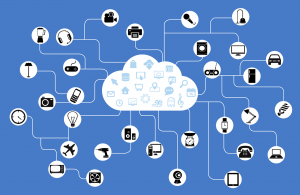 Click to learn more about author Gilad David Maayan.
Click to learn more about author Gilad David Maayan.
The Internet of Things (IoT) is an increasingly growing network of physical devices and objects connected to the Internet and, in some cases, to each other. These devices are often equipped with sensors, and, as IBM describes, they can both gather and share data about how they are used and about the environment around them.
IoT has the potential to deliver profound impacts both economically and socially. Read on to find out the relevance of IoT for the supply chain and five specific benefits of IoT to supply chains.
IoT and Supply Chain Management
The idea of a supply chain comes from the fact that the production of any product is inherently dependent on a series of links or connections. Weaken those connections, whether through transport delays, outdated machinery, or operational errors, and you end up with a poorly functioning supply chain in which costs are high and profit margins are low.
Through its network of sensors, the IoT provides a much-needed link in the supply chain between the physical world of objects and the world of information, or data. This data can then be transmitted over the Internet, aggregated, and analyzed using powerful analytics engines to drive better decisions and optimizations to any given supply chain.
From oil pipelines to warehouses to shipping containers to individual products, the IoT has use cases and benefits right across the supply chain. Real-time end-to-end visibility drives a competitive edge for companies implementing the IoT into supply chains.
Five Benefits of IoT In Supply Chains
1.Unparalleled Transparency
As customers become more discerning in terms of choosing to purchase products that are produced sustainably and ethically, visibility into supply chains is becoming pivotal. Furthermore, the greater the visibility into a supply chain, the more likely it is to function smoothly.
According to 2016 research, 70 percent of companies had experienced at least one supply chain interruption during the previous 12 months. Using a range of sensor-equipped machines and devices across the supply chain, information can flow much more freely with potential issues or stumbling blocks being flagged in real-time, delivering unparalleled supply chain transparency.
2.Improved Last Mile Delivery
The last mile is arguably the most important step of the supply chain journey of a product from manufacturers to end users or customers. Retailers are faced with a slew of concerns in terms of optimizing their last mile delivery processes because the delivery experience has profound impacts on the chances of repeat orders.
Companies are looking to a range of last mile technology solutions to improve their last mile delivery. The information garnered from the use of IoT devices in a supply chain can help to optimize last mile delivery by catching potential issues and changing auto-delivery systems and truck routes based on that information, which can even incorporate current weather conditions.
3.Predictive Maintenance
Supply chains depend on manufacturers being able to move finished products along the supply chain in a timely manner to the next user, whether that user is a retailer who will deliver goods to end customers or another manufacturer using smaller components to create larger machines.
A large stumbling block often encountered is the failure of manufacturing equipment, downtime for which causes ripple effects across entire supply chains. Using the next generation of IoT manufacturing equipment, fitted with sensors, manufacturers can fix issues before they even occur. This type of predictive maintenance is much more efficient than reactive maintenance.
4.Operational Efficiencies
IoT devices can keep track of inventories much more efficiently than humans can manage. Amazon, for example, uses robots with Wi-Fi connectivity to track inventories and orders using QR codes, which the robot scans and sends to a database. This type of inventory tracking is not only more efficient than human inventory management, but it also leads to fewer errors.
Furthermore, the data you gather from IoT inventory management can be analyzed and used to further optimize your operations. For example, more accurate inventories can drive automated ordering of additional supplies exactly when needed.
5. Better Tracking and Tracing
Supply chains for perishable goods are notoriously complex to manage. The probability of a perishable product making it to an end customer depends on a whole host of factors. In particular, optimal shipping conditions are imperative. Just a few degrees too hot or too warm can spoil a product.
Intel revealed that 30 percent of all perishable produce never makes it all the way from the farm to the table, which is an incredible amount of waste. IoT can assist with improving this percentage through the use of sensors that give detailed real-time information on conditions within shipping containers. Preventative measures can then be taken to save the product before it spoils.
Wrap Up
The benefits of IoT for supply chain management are undeniable, and as more devices become connected to these networks and further optimizations are realized, those benefits will only grow in number.
Photo Credit: Pixabay
